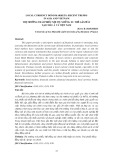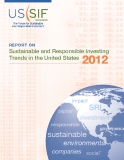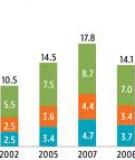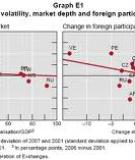
Local currency bonds
-
This paper provides a descriptive analysis of financial systems in emerging Asia, assessing the dimensions of the current state of bond markets. In particular, local currency bond markets have expanded dramatically since governments took steps to end the currency and maturity mismatches that savaged borrowers in the region’s financial crisis nearly twenty years ago.
 22p
22p  viuchinaga2711
viuchinaga2711
 21-10-2021
21-10-2021
 15
15
 0
0
 Download
Download
-
The authorities have made continuous efforts to build benchmarks at different points along the yield curve. The aim of this strategy is to further develop the interest rate term structure in the local currency, which would allow better pricing and liquidity of bonds issued both by the government itself and by the private sector. To this end, the authorities have increased the average maturity of the outstanding debt and smoothed its maturity profile.
 19p
19p  hongphuocidol
hongphuocidol
 04-04-2013
04-04-2013
 66
66
 7
7
 Download
Download
-
There has been substantial progress in the development of the government bond market. Key steps include a lengthening of the yield curve, reduction in external exposure and diversification of the investor base. This has been supported by improved macroeconomic conditions, foreign investors entering the fixed rate segment of local currency government debt, and well designed microstructure reforms regarding issuance policy and auction process. As shown below, the government bond market has become more resilient to various risk factors. ...
 29p
29p  hongphuocidol
hongphuocidol
 04-04-2013
04-04-2013
 60
60
 9
9
 Download
Download
-
Financial development is important for fostering economic growth and stability. This is a feature of the development process that has been extensively documented in the literatures (see Levine). 1 One of key components in this process is capital market development. For example, deepening the long-term local bond market facilitates the reduction of currency and maturity mismatches on corporations’ balance sheets. This also creates alternatives to bank financing that can support efficiency and stability.
 27p
27p  hongphuocidol
hongphuocidol
 04-04-2013
04-04-2013
 61
61
 8
8
 Download
Download
-
Viewing migrant networks as an information transmission mechanism influencing investment is a natural extension of existing work trade in the absence of formal institutions. Drawing on Grief’s (1989, 1993) work on the Maghribi traders of the 11th century, Rauch and Trindade (2002) provide empirical evidence that the overseas Chinese help link buyers to sellers across national borders. Giving pride of place to migrant networks in explaining the cross-national distribution of capital allows us to speak to a number of seemingly disparate literatures.
 34p
34p  enter1cai
enter1cai
 16-01-2013
16-01-2013
 46
46
 2
2
 Download
Download
-
The first set of factors lower the cost of default. Default propensity is exaggerated by state laws providing for a greater amount of homestead protection or for less-than-full recourse on the defaulting borrowers by lenders. This is because they shield a greater proportion of the borrower’s wealth and income from capture by the lender post-default and, (if applicable), a subsequent bankruptcy.
 142p
142p  enter1cai
enter1cai
 16-01-2013
16-01-2013
 46
46
 4
4
 Download
Download
-
We analyze the development of 49 local bond markets. Our main finding is that policies and laws matter: Countries with stable inflation rates and strong creditor rights have more developed local bond markets and rely less on foreign-currency-denominated bonds. The results suggest that “original sin” is a misnomer. Emerging economies are not inherently dependent upon foreign-currency debt. Rather, by improving policy performance and strengthening institutions they may develop local currency bond markets, reduce their currency mismatch, and lessen the likelihood of future crises....
 22p
22p  taisaocothedung
taisaocothedung
 12-01-2013
12-01-2013
 53
53
 2
2
 Download
Download
-
Since the 1997 Asian financial crisis, bond market development has become a high priority for Asian policymakers. The development of local currency bond markets has often been seen as a way to avoid crisis, with these markets helping reduce potential currency and maturity mismatches in the economy. Indeed, several Asian economies have succeeded in developing fairly active primary and secondary markets in domestic government bonds. In recent years, policymakers in many Asian economies have started to turn their attention to local currency non-government (“corporate”) bond markets.
 11p
11p  taisaocothedung
taisaocothedung
 12-01-2013
12-01-2013
 66
66
 4
4
 Download
Download
-
A special feature in the BIS Quarterly Review of June 2004 profiled the Asian local currency bond markets as a potential asset class, contrasting their considerable capitalisation with their mixed liquidity. The article found that larger markets with larger issues saw more trading at narrower bid-ask spreads. For a market of a given size, concentration of holdings among investors depresses liquidity. A broader investor base might thus be expected to improve liquidity, particularly at times of stress (Jiang and McCauley (2004)).
 16p
16p  taisaocothedung
taisaocothedung
 12-01-2013
12-01-2013
 49
49
 1
1
 Download
Download
-
Domestic bond markets have remained underdeveloped for much of Latin America’s modern history owing to a number of policy and structural impediments. The resulting structure of domestic government and private sector debt, which was heavily biased towards short-term and/or dollar-indexed liabilities, contributed to a worsening of the financial crises in the region during the 1990s and early 2000s. In recent years, however, domestic bond markets have constituted a growing source of financing for Latin American economies and of portfolio allocation for global investors (Figure 1).
 19p
19p  taisaocothedung
taisaocothedung
 12-01-2013
12-01-2013
 46
46
 1
1
 Download
Download
CHỦ ĐỀ BẠN MUỐN TÌM























